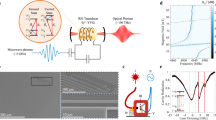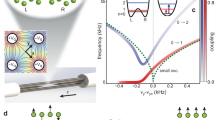Abstract
More than 100 years ago, Hertz succeeded in transmitting signals over a few metres to a receiving antenna using an electromagnetic oscillator, thus proving the electromagnetic theory1 developed by Maxwell. Since this seminal work, technology has developed, and various oscillators are now available at the quantum mechanical level. For quantized electromagnetic oscillations, atoms in cavities can be used to couple electric fields2,3. However, a quantum mechanical link between two mechanical oscillators (such as cantilevers4,5 or the vibrational modes of trapped atoms6 or ions7,8) has been rarely demonstrated and has been achieved only indirectly. Examples include the mechanical transport of atoms carrying quantum information9 or the use of spontaneously emitted photons10. Here we achieve direct coupling between the motional dipoles of separately trapped ions over a distance of 54 micrometres, using the dipole–dipole interaction as a quantum mechanical transmission line11. This interaction is small between single trapped ions, but the coupling is amplified by using additional trapped ions as antennae. With three ions in each well, the interaction is increased by a factor of seven compared to the single-ion case. This enhancement facilitates bridging of larger distances and relaxes the constraints on the miniaturization of trap electrodes. The system provides a building block for quantum computers and opportunities for coupling different types of quantum systems.
This is a preview of subscription content, access via your institution
Access options
Subscribe to this journal
Receive 51 print issues and online access
$199.00 per year
only $3.90 per issue
Buy this article
- Purchase on Springer Link
- Instant access to full article PDF
Prices may be subject to local taxes which are calculated during checkout




Similar content being viewed by others
References
Hertz, H. Über die Grundgleichungen der Electrodynamik für bewegte Körper. Ann. Phys. Chem. 277, 369–399 (1890)
Kuhr, S. et al. Ultrahigh finesse Fabry-Perot superconducting resonator. Appl. Phys. Lett. 90, 164101 (2007)
Gleyzes, S. et al. Quantum jumps of light recording the birth and death of a photon in a cavity. Nature 446, 297–300 (2007)
Anetsberger, G. et al. Near-field cavity optomechanics with nanomechanical oscillators. Nature Phys. 5, 909–914 (2009)
Schliesser, A., Del'Haye, P., Nooshi, N., Vahala, K. J. & Kippenberg, T. J. Radiation pressure cooling of a micromechanical oscillator using dynamical backaction. Phys. Rev. Lett. 97, 243905 (2006)
Kinoshita, T., Wenger, T. & Weiss, D. S. A quantum Newton's cradle. Nature 440, 900–903 (2006)
Leibfried, D., Blatt, R., Monroe, C. & Wineland, D. Quantum dynamics of single trapped ions. Rev. Mod. Phys. 75, 281–324 (2003)
Monroe, C., Meekhof, D. M., King, B. E. & Wineland, D. J. A “Schrödinger Cat” superposition state of an atom. Science 272, 1131–1136 (1996)
Jost, J. D. et al. Entangled mechanical oscillators. Nature 459, 683–685 (2009)
Blinov, B. B., Moehring, D. L., Duan, L.-M. & Monroe, C. Observation of entanglement between a single trapped atom and a single photon. Nature 428, 153–157 (2004)
Cirac, J. I. & Zoller, P. A scalable quantum computer with ions in an array of microtraps. Nature 404, 579–581 (2000)
DiVincenzo, D. P. The physical implementation of quantum computation. Fortschr. Phys. 48, 771–783 (2000)
Kielpinski, D., Monroe, C. & Wineland, D. J. Architecture for a large-scale ion-trap quantum computer. Nature 417, 709–711 (2002)
Deslauriers, L. et al. Scaling and suppression of anomalous heating in ion traps. Phys. Rev. Lett. 97, 103007 (2006)
Seidelin, S. et al. Microfabricated surface-electrode ion trap for scalable quantum information processing. Phys. Rev. Lett. 96, 253003 (2006)
Leibrandt, D. R. et al. Modeling ion trap thermal noise coherence. Quant. Inform. Comput. 7, 052–072 (2007)
Labaziewicz, J. et al. Suppression of heating rates in cyrogenic surface-electrode ion traps. Phys. Rev. Lett. 100, 013001 (2008)
Cirac, J. I. & Zoller, P. Quantum computations with cold trapped ions. Phys. Rev. Lett. 74, 4091–4094 (1995)
Schulz, S. A., Poschinger, U., Ziesel, F. & Schmidt-Kaler, F. Sideband cooling and coherent dynamics in a microchip multi-segmented ion trap. N. J. Phys. 10, 045007 (2008)
Roos, C. F. et al. Quantum state engineering on an optical transition and decoherence in a Paul trap. Phys. Rev. Lett. 83, 4713–4716 (1999)
Meekhof, D. M., Monroe, C., King, B. E., Itano, W. M. & Wineland, D. J. Generation of nonclassical motional states of a trapped atom. Phys. Rev. Lett. 76, 1796–1799 (1996)
Turchette, Q. A. et al. Heating of trapped ions from the quantum ground state. Phys. Rev. A 61, 063418 (2000)
Brown, K. R. et al. Coupled quantized mechanical oscillators. Nature doi:10.1038/nature09721 (this issue).
Benhelm, J. et al. Towards fault-tolerant quantum computing with trapped ions. Nature Phys. 4, 463–466 (2008)
Sørensen, A. & Mølmer, K. Quantum computation with ions in thermal motion. Phys. Rev. Lett. 82, 1971–1974 (1999)
Raussendorf, R., Browne, D. E. & Briegel, H. J. Measurement-based quantum computation on cluster states. Phys. Rev. A 68, 022312 (2003)
Urban, E. et al. Observation of Rydberg blockade between two atoms. Nature Phys. 5, 110–114 (2009)
Zipkes, C., Palzer, S., Sias, C. & Köhl, M. A trapped single ion inside a Bose-Einstein condensate. Nature 464, 388–391 (2010)
Schmid, S., Härter, A. & Denschlag, J. H. Dynamics of a cold trapped ion in a Bose-Einstein condensate. Phys. Rev. Lett. 105, 133202 (2010)
Home, J. P. & Steane, A. M. Electrode configuration for fast separation of trapped ions. Quant. Inform. Comput. 6, 289–325 (2006)
Acknowledgements
We thank H. Häffner for discussions at an early state of the project. We acknowledge the support of the EU STREP project MICROTRAP, the Austrian Science Fund (FWF), the EU network SCALA, the European Research Council (ERC) and the Institut für Quanteninformation GmbH.
Author information
Authors and Affiliations
Contributions
The experiments were performed by M.H., R.L. and W.H.; M.H., M.B., R.L., W.H. and R.B. contributed to the set-up; the data analysis was performed by M.H. and W.H.; the original idea was devised by W.H. and R.B.; and all authors contributed to the discussion of the results and participated in manuscript preparation.
Corresponding author
Ethics declarations
Competing interests
The authors declare no competing financial interests.
Rights and permissions
About this article
Cite this article
Harlander, M., Lechner, R., Brownnutt, M. et al. Trapped-ion antennae for the transmission of quantum information. Nature 471, 200–203 (2011). https://doi.org/10.1038/nature09800
Received:
Accepted:
Published:
Issue Date:
DOI: https://doi.org/10.1038/nature09800
This article is cited by
-
Exploring quasi-probability Husimi-distributions in nonlinear two trapped-ion qubits: intrinsic decoherence effects
Optical and Quantum Electronics (2024)
-
Scalable and programmable phononic network with trapped ions
Nature Physics (2023)
-
Temperature estimation of a pair of trapped ions
Scientific Reports (2022)
-
Charged particle guiding and beam splitting with auto-ponderomotive potentials on a chip
Nature Communications (2021)
-
Sympathetic cooling of a trapped proton mediated by an LC circuit
Nature (2021)
Comments
By submitting a comment you agree to abide by our Terms and Community Guidelines. If you find something abusive or that does not comply with our terms or guidelines please flag it as inappropriate.



